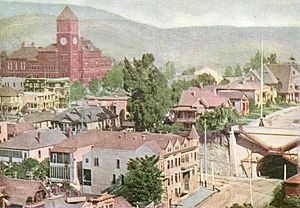Broadway Tunnel (Los Angeles) facts for kids
 |
|
| The opening to the Broadway Tunnel under Fort Moore Hill is at lower right. Los Angeles High School is in upper left. | |
| Overview | |
|---|---|
| Location | Los Angeles, California, USA |
| Status | Demolished for construction of Hollywood Freeway |
| Route | North Broadway |
| Start | Sand Street (later California Street), one block north of Temple Street |
| End | North side of Fort Moore Hill |
| Operation | |
| Work begun | November 2, 1899 |
| Closed | June 2, 1949 |
| Owner | The city |
| Character | Street traffic |
| Technical | |
| Length | 760 feet (230 m) |
| Number of lanes | Two |
| Tunnel clearance | 22 feet (6.7 m) |
| Width | 40 feet (12 m) |
| Grade | 6 in 100 |
The Broadway Tunnel was a special underground passage in Downtown Los Angeles, California. It went under a place called Fort Moore Hill. This tunnel helped connect different parts of North Broadway street. It started near Temple Street and went northeast to where Bellevue Avenue (now Cesar Chavez Avenue) met Buena Vista Street (now also North Broadway).
The Story of the Broadway Tunnel
People started talking about building a tunnel under Fort Moore Hill way back in 1891. They wanted to connect Broadway street all the way from the southern edge of the city to the Eastside. This would create one long, wide road for everyone to use.
By 1895, city engineers had drawn up plans for the tunnel. The main reason for building it was to help with the growing amount of traffic. Back then, traffic meant horses, buggies, and wagons. There was a big traffic jam problem at the corner of First and Spring Streets. A new tunnel would give people another way to get around and ease the crowding.
How Was It Built?
Work on the Broadway Tunnel began on November 2, 1899. About 25 workers and their animal teams started clearing the way. They moved dirt and other things to prepare for digging. On January 20, 1900, a worker was buried by about 20 tons of earth. Luckily, the wooden supports fell in a way that saved him from being crushed.
Building the tunnel was a huge job! It needed over 50,000 cubic yards of dirt to be moved. It also used 4,000 cubic yards of concrete and 1.25 million bricks to line the inside. At the time, the Broadway Tunnel was one of the widest tunnels of its kind in the United States, and possibly the world. It was 40 feet wide, which was wide enough for another tunnel, the Third Street Tunnel, to fit inside it with room for an 8-foot wide sidewalk!
The Broadway Tunnel was finished and opened for traffic on Saturday, August 17, 1901. It was 760 feet long, 40 feet wide, and 22 feet high. It cost $66,000 to build.
Making It Better
In 1915, the Broadway Tunnel was closed for a big update. The road inside was lowered to make the slope less steep. They also put in a new wood block floor. This made the surface quieter for cars and horse-drawn wagons. A false roof was built inside the original tunnel. Because the road was lowered, nearby streets also had to be changed.
The concrete archway of the tunnel was 20 feet high. The entire inside was lined with shiny white glazed tiles. A stairway on the outside of the southern entrance was made longer, rising 65 feet up to Fort Moore Hill.
The renovation was completed, and the Broadway Tunnel reopened in early February 1916. Because so many cars, teams, and pedestrians would use it every day, a special event was held on February 19. The tunnel was officially given back to the city, with the Automobile Club of Southern California helping to celebrate.
Why Did It Disappear?
The Broadway Tunnel was closed for good on June 2, 1949. It was taken down to make way for the new Hollywood Freeway. This freeway cut right through Fort Moore Hill. Because of this, a new overpass for Broadway street had to be built right where the old tunnel used to be.

